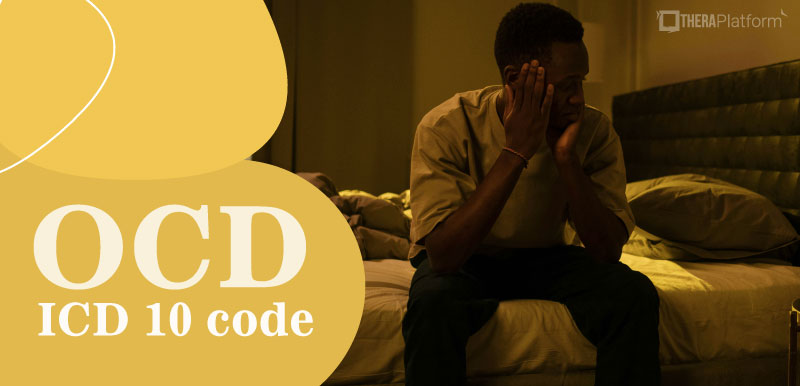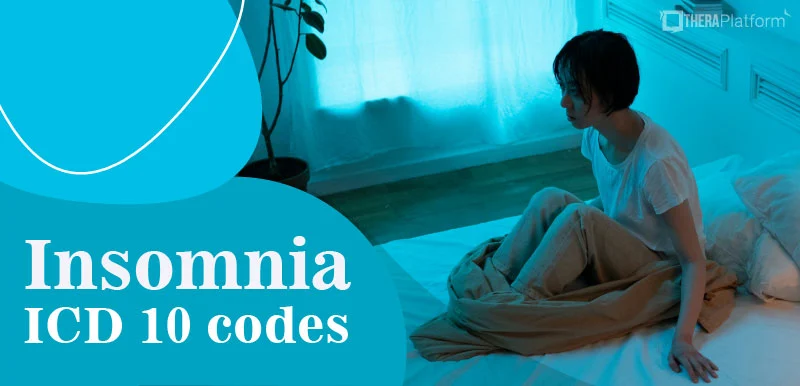F43.23 ICD 10 code

F43.23 is the ICD-10 code used for Adjustment Disorder with Mixed Anxiety and Depressed Mood. Therapists use this code to classify a condition where an individual experiences both anxiety and depressive symptoms in response to a significant stressor. Unlike other mood disorders, the symptoms of Adjustment Disorder are directly linked to a specific stressor and resolve once the stressor is removed or the individual adapts to it.
Summary
- Unlike Major Depressive Disorder or Generalized Anxiety Disorder, the symptoms of Adjustment Disorder with Mixed Anxiety and Depressed Mood are directly tied to a particular stressor. They are expected to resolve once the stressor is removed or the individual adapts.
- Symptoms must emerge within three months of the stressor and typically resolve within six months after the stressor ends. If symptoms persist beyond this timeframe, another diagnosis may be more appropriate.
- Cognitive Behavioral Therapy (CBT), mindfulness techniques, and supportive therapy are effective treatments. In some cases, clients may use short-term medication to help alleviate severe symptoms.
- Proper use of the F43.23 ICD-10 code ensures that clients receive appropriate care and insurance reimbursement. Enrolling in an insurance billing course for therapists can help providers enhance their knowledge. Clinicians must detail the stressor, symptoms, functional impairment, and treatment interventions.
- By leveraging an EHR like TheraPlatform for efficient documentation and claim submission, therapists can improve compliance with HIPAA and payer guidelines, ensure timely reimbursement, and enhance overall billing accuracy for services.
→ Click here to enroll in our free on-demand Insurance Billing for Therapists video course [Enroll Now]
The primary purpose of the F43.23 ICD-10 code is to document a client’s emotional and behavioral response to a significant stressor. This code helps therapists and healthcare providers to accurately diagnose and treat clients who are struggling with mixed anxiety and depressive symptoms. It also aids in billing and reimbursement, ensuring clients receive appropriate care without financial barriers.
Streamline your insurance billing with One EHR
- Claim batching
- Auto claims
- Automated EOB & ERA
- Real-time claim validation
- Real-time claim tracking
- Aging and other reports

Symptoms and Criteria for using the F43.23 ICD-10 code
- Primary symptoms: The symptoms of Adjustment Disorder with Mixed Anxiety and Depressed Mood can be broadly categorized into anxiety and depression.
- Anxiety: Clients may experience restlessness, excessive worry, difficulty concentrating, and a sense of impending doom. These symptoms can be debilitating and interfere with daily functioning.
- Depression: Symptoms of depression include persistent sadness, hopelessness, lack of energy, changes in appetite or sleep patterns, and a loss of interest in previously enjoyed activities. These symptoms can significantly impact a client’s quality of life.
- Timeframe: One of the key diagnostic criteria for the F43.23 ICD-10 code is the timeframe for the symptoms. Typically, symptoms manifest within three months of the onset of the stressor. If the stressor or its consequences are removed, the symptoms are expected to resolve within six months. However, if the symptoms persist beyond this period, it may be necessary to consider other diagnoses.
- Stressors: The stressors that trigger Adjustment Disorder can vary widely but generally include significant life events such as job loss, divorce, relocation, or the death of a loved one. These events can disrupt an individual’s sense of stability and security, leading to the development of anxiety and depressive symptoms.
Watch this video to learn common insurance billing struggles and solutions
→ Start My Free Trial
→ Start My Free Trial
Differential diagnosis
Differentiating the F43.23 ICD-10 code from other conditions
When diagnosing Adjustment Disorder with Mixed Anxiety and Depressed Mood (F43.23), it’s essential to distinguish it from other mental health conditions that may look similar but have different causes and treatment approaches.
Here’s how to tell them apart:
Major Depressive Disorder (MDD)
- Key difference: MDD involves intense and long-lasting depressive symptoms that aren’t necessarily tied to a specific stressor. In contrast, Adjustment Disorder symptoms are directly linked to a recent stressor.
- Symptoms: MDD includes severe symptoms like deep sadness, loss of interest in activities, changes in appetite or sleep, and feelings of worthlessness that last for at least two weeks. These symptoms are more persistent and severe than those seen in Adjustment Disorder.
- Example: A client with MDD might feel hopeless and lose interest in life for no clear reason, while a client with Adjustment Disorder might feel sad and anxious after losing their job.
Generalized Anxiety Disorder (GAD)
- Key difference: GAD involves chronic, excessive worry about many areas of life (e.g., health, work, relationships) that isn’t tied to a specific event. Adjustment Disorder, on the other hand, is directly connected to a particular stressor.
- Symptoms: GAD includes constant worry, restlessness, fatigue, and difficulty concentrating for at least six months. These symptoms are broader and more long-term than those in Adjustment Disorder.
- Example: A client with GAD might worry constantly about everything, from their finances to their health, while a client with Adjustment Disorder might feel anxious and overwhelmed only after a specific event, like a divorce.
Post-Traumatic Stress Disorder (PTSD)
- Key difference: PTSD is caused by exposure to a traumatic event (e.g., war, assault, or a natural disaster) and involves symptoms like flashbacks, nightmares, and avoidance of reminders of the trauma. Adjustment Disorder, however, is triggered by a less severe stressor and doesn’t involve these trauma-specific symptoms.
- Symptoms: PTSD includes re-experiencing the trauma (e.g., flashbacks), avoiding triggers, feeling on edge, and having negative changes in mood and thoughts. These symptoms are more intense and specific than those in Adjustment Disorder.
- Example: A client with PTSD might have nightmares and avoid crowded places after surviving a car accident, while a client with Adjustment Disorder might feel anxious and sad after moving to a new city but won’t experience flashbacks or hypervigilance.
Focus on the stressor
Stressors are the key to diagnosing adjustment disorder. Unlike other conditions, the symptoms of F43.23 are directly tied to a specific event or situation.
Here’s what to focus on:
Identifying the stressor
- What happened?: Identify the event or situation that triggered the client’s symptoms. This could be anything from a breakup or job loss to a health issue or family conflict.
- When did it happen?: Note when the stressor occurred. Adjustment Disorder symptoms typically begin within three months of the stressor.
- How severe is it?: Assess the intensity of the stressor. While it doesn’t have to be traumatic, it should be significant enough to cause emotional distress.
Linking the stressor to symptoms
- Temporal relationship: Show how the symptoms are connected to the stressor. For example, if a client started feeling anxious and depressed after losing their job, document how the job loss led to these feelings.
- Impact on functioning: Explain how the stressor has affected the client’s daily life. Are they struggling at work, avoiding social activities, or having trouble sleeping? These details help confirm the diagnosis.
Assessing the timeline
- Duration of symptoms: Adjustment Disorder symptoms typically last no longer than six months after the stressor has ended. If symptoms persist beyond this timeframe, consider other diagnoses, such as MDD or GAD.
- Chronic stressors: If the stressor is ongoing (e.g., a difficult work environment), the symptoms may continue as long as the stressor is present. However, if symptoms become more severe or long-lasting, reevaluate the diagnosis.
Why this matters
Differentiating Adjustment Disorder from other conditions ensures clients receive the right diagnosis and treatment. By focusing on the stressor and its connection to the symptoms, therapists can provide targeted care that addresses the root cause of the client’s distress, improving outcomes and helping with accurate billing and insurance reimbursement.
Practice Management + EHR + Telehealth
Manage more in less time in your practice with TheraPlatform

Treatment considerations for Adjustment Disorder with Mixed Anxiety and Depressed Mood
Therapeutic approaches
Effective treatment for Adjustment Disorder with Mixed Anxiety and Depressed Mood often involves a combination of therapeutic approaches tailored to the individual’s needs.
- Cognitive Behavioral Therapy (CBT): CBT is a widely used approach that helps clients identify and challenge negative thought patterns contributing to their anxiety and depression. By restructuring these thoughts, clients can develop healthier coping mechanisms and improve their emotional well-being.
- Mindfulness and relaxation techniques: These techniques can be particularly beneficial for managing anxiety symptoms. Practices such as deep breathing, progressive muscle relaxation, and mindfulness meditation can help clients reduce their overall stress levels and improve their ability to cope with the stressor.
- Supportive therapy: Focuses on providing emotional support and helping clients process the stressor. It can also involve developing practical coping skills to manage the stressor’s impact on daily life.
- Medication: In cases where symptoms are severe and significantly impair the client’s functioning, pharmacological intervention may be necessary. Collaboration with a psychiatrist can help determine the appropriate medication, such as antidepressants or anti-anxiety medications, to alleviate symptoms. However, medication is typically considered a short-term solution, with the primary focus remaining on therapeutic interventions.
Documentation and billing for the F43.23 ICD-10 code
Documentation requirements
Accurate and thorough documentation is a cornerstone of effective clinical practice and billing. When using the F43.23 code (Adjustment Disorder with Mixed Anxiety and Depressed Mood), therapists must ensure that their records are detailed, precise, and aligned with both clinical and insurance requirements.
Proper documentation supports the diagnosis and facilitates appropriate treatment planning and reimbursement.
Below are the key elements to include:
- Identified stressor: The stressor is the triggering event or circumstance that has led to the client’s symptoms. Documenting the stressor is critical for justifying the diagnosis and ensuring the treatment is tailored to the client’s needs.
Include the following details:
- Nature of the stressor: Describe the specific event or situation (e.g., job loss, divorce, illness, relocation, or financial difficulties). Be as specific as possible.
- Onset and duration: Note when the stressor occurred and whether it is acute or chronic. For example, was it a single event or an ongoing situation?
- Impact on the client: Explain how the stressor has affected the client’s emotional, psychological, and functional well-being. For instance, has it led to feelings of hopelessness, difficulty concentrating, or social withdrawal?
Anxiety and Depressive symptoms
The F43.23 code requires evidence of both anxiety and depressive symptoms.
Documenting these symptoms in detail helps to validate the diagnosis and ensures that the treatment plan addresses the client’s unique needs.
Include:
- Specific symptoms: List the anxiety symptoms (e.g., excessive worry, restlessness, irritability) and depressive symptoms (e.g., sadness, loss of interest, fatigue) the client is experiencing.
- Severity and frequency: Describe the intensity of the symptoms (mild, moderate, or severe) and how often they occur. For example, are the symptoms persistent, or do they fluctuate?
- Duration: Note how long the symptoms have been present. Adjustment disorders typically occur within three months of the stressor and last no longer than six months after the stressor has ended unless chronic.
Functional impairments
Functional impairments are a key component of the F43.23 diagnosis. Documenting how the client’s symptoms affect their daily life is essential for clinical and billing purposes.
Include:
- Areas of impact: Identify specific areas of the client’s life that have been disrupted, such as work performance, academic functioning, relationships, or self-care.
- Examples of impairment: Provide concrete examples. For instance, has the client missed work or school due to their symptoms? Are they struggling to maintain relationships or complete daily tasks?
- Prognosis and treatment goals: Outline how the impairments are addressed in therapy and what improvements are expected. This helps to demonstrate the medical necessity of the treatment.
Billing tips for F43.23 code
Accurate coding and billing are essential for ensuring that clients receive the care they need and that therapists are reimbursed for their services.
When billing for services related to F43.23, therapists should follow these best practices:
Ensure accurate coding
- Double-check the code: Verify that the F43.23 code is correctly entered in the client’s medical records and billing documents. Errors in coding can lead to claim denials or delays in reimbursement.
- Stay updated: Keep abreast of any changes to coding guidelines or insurance requirements related to adjustment disorders to ensure compliance and reduce the risk of billing issues.
Provide supporting clinical notes
- Detailed documentation: Include comprehensive clinical notes that support using the F43.23 code.
These notes should cover:
- The identified stressor and its impact.
- The client’s anxiety and depressive symptoms, including severity and duration.
- Functional impairments and how they are addressed in therapy.
- Therapeutic Interventions: Document the specific interventions used to treat the client’s symptoms (e.g., cognitive-behavioral therapy, mindfulness techniques, or stress management strategies). This demonstrates the medical necessity of the treatment.
- Progress notes: Update the client’s progress regularly, including any changes in symptoms or functioning. This helps justify ongoing treatment and supports insurance claims.
Communicate with insurance providers
- Pre-authorization: Before beginning treatment, obtain pre-authorization from the client’s insurance provider to ensure that the services will be covered.
- Clarify coverage: Verify the client’s insurance benefits, including the number of sessions covered and any co-pays or deductibles. This helps to avoid unexpected costs for the client.
- Appeals process: If a claim is denied, be prepared to submit additional documentation or appeal the decision. Clear and detailed clinical notes are critical in this process.
Maintain ethical and legal standards
- Confidentiality: Ensure all documentation complies with HIPAA regulations and protects the client’s privacy.
- Accuracy: Avoid over-documenting or under-documenting. Be truthful and precise in your notes to maintain ethical standards and avoid legal issues.
Importance of F43.23
The F43.23 code is vital in capturing the complexity of mixed emotional responses to life stressors. By accurately diagnosing and documenting Adjustment Disorder with Mixed Anxiety and Depressed Mood, therapists can provide targeted and effective treatment that addresses both the emotional symptoms and the underlying stressor.
As a therapist, your role is crucial in helping clients navigate the challenges of Adjustment Disorder. Providing a supportive and understanding environment can help clients process their stressors, develop effective coping mechanisms, and improve their emotional well-being. Accurate diagnosis and documentation, using the F43.23 code, ensures that clients receive the care they need and that your services are appropriately reimbursed.
Practice Management + EHR + Telehealth
Manage more in less time in your practice with TheraPlatform

How EHR and practice management software can save you time with insurance billing for therapists
EHRs with integrated billing software and clearing houses, such as TheraPlatform, offer therapists significant advantages in creating an efficient insurance billing process. The key is minimizing the amount of time dedicated to developing, sending, and tracking medical claims through features such as automation and batching.
What are automation and batching?
- Automation refers to setting up software to perform tasks with limited human interaction.
- Batching or performing administrative tasks in blocks of time at once allows you to perform a task from a single entry point with less clicking.
Which billing and medical claim tasks can be automated and batched through billing software?
- Invoices: Create multiple invoices for multiple clients with a click or two of a button or set up auto-invoice creation, and the software will automatically create invoices for you at the preferred time. You can even have the system automatically send invoices to your clients.
- Credit card processing: Charge multiple clients with a click of a button or set up auto credit card billing, and the billing software will automatically charge the card (easier than swiping!)
- Email payment reminders: Never manually send another reminder email for payment again, or skip this altogether by enabling auto credit card charges.
- Automated claim creation and submission: Batch multiple claims with one button click or turn auto claim creation and submission on.
- Live claim validation: The system reviews each claim to catch any human errors before submission, saving you time and reducing rejected claims.
- Automated payment posting: Streamline posting procedures for paid medical claims with ERA. When insurance offers ERA, all their payments will post automatically on TheraPlatform's EHR.
- Tracking: Track payment and profits, including aging invoices, overdue invoices, transactions, billed services, service providers.
Utilizing billing software integrated with an EHR and practice management software can make storing and sharing billing and insurance easy and save providers time when it comes to insurance billing for therapists.
Streamline your practice with One EHR
- Scheduling
- Flexible notes
- Template library
- Billing & payments
- Insurance claims
- Client portal
- Telehealth
- E-fax

Resources
Theraplatform is an all-in-one EHR, practice management and teletherapy solution that allows you to focus more on patient care. With a 30-day free trial, you have the opportunity to experience Theraplatform for yourself with no credit card required. Cancel anytime. They also support different industries including mental and behavioral health therapists in group practices and solo practices.
More resources
- Therapy resources and worksheets
- Therapy private practice courses
- Ultimate teletherapy ebook
- The Ultimate Insurance Billing Guide for Therapists
- The Ultimate Guide to Starting a Private Therapy Practice
- Mental health credentialing
- Insurance billing 101
- Practice management tools
- Behavioral Health tools
Free video classes
- Free on-demand insurance billing for therapist course
- Free mini video lessons to enhance your private practice
- 9 Admin tasks to automate in your private practice
References
American Psychiatric Association. (2013). Diagnostic and statistical manual of mental disorders (5th ed.). American Psychiatric Publishing.
World Health Organization. (2016). International statistical classification of diseases and related health problems (10th ed.). World Health Organization. Retrieved from https://www.who.int/classifications/icd/en/
Hofmann, S. G., Asnaani, A., Vonk, I. J., Sawyer, A. T., & Fang, A. (2012). The Efficacy of Cognitive Behavioral Therapy: A Review of Meta-analyses. Cognitive Therapy and Research, 36(5), 427-440. https://doi.org/10.1007/s10608-012-9476-1 https://pubmed.ncbi.nlm.nih.gov/23459093/
National Institute for Health and Care Excellence (NICE). (2019). Generalised anxiety disorder and panic disorder in adults: Management. NICE Guidelines. Retrieved from https://www.nice.org.uk/guidance/ng113
Cohen, A., & Hearn, J. (2020). Clinical management of Adjustment Disorders: Evidence and treatment approaches. Journal of Clinical Psychology, 78(3), 531-543. https://doi.org/10.1002/jclp.22979



